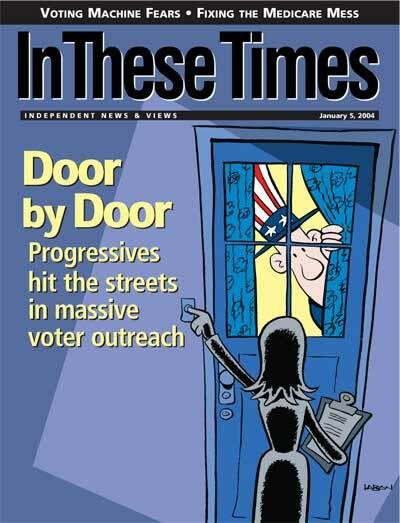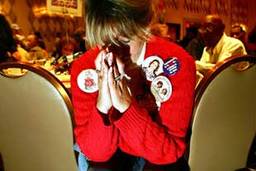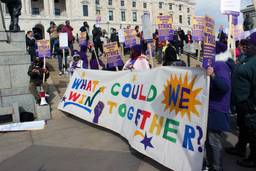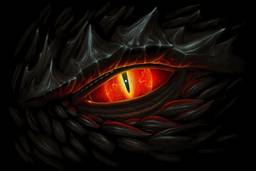At the November protests against the Free Trade Agreement of the Americas (FTAA) negotiations, Police Chief John Timoney and the Bush administration’s Department of Homeland Security launched a violent assault on American democracy.
With $8.5 million supplied from the famous $87 billion allocated for the War on Terror, thousands of officers from the Miami-Dade Police Department and several federal agencies, including the DEA, the ATF, INS and the U.S. Fish and Wildlife Services, were armed with weapons ranging from tear gas to tazer guns, rubber bullets and water cannons.
The police unleashed these weapons against a parade of AFL-CIO marchers and a few thousand other activists, whose most militant ambition was to repeat the symbolic victory of Quebec City by pulling down a large “anarchist-proof” wall surrounding the hotel in which negotiators were meeting. These same forces also were used to prevent busloads of protesters from disembarking and to detain marchers attempting to leave downtown.
Observers have characterized this response as an act of desperation: Since thousands of activists shut down WTO meetings four years ago in Seattle, the FTAA has been in a tailspin, threatened by nonviolent global uprising. And it is clear that the “Miami Model,” as law enforcement officials are calling this overwhelming response, had goals beyond keeping the peace.
Seeking to control spin, Timoney “embedded” reporters from mainstream media outlets in police operations. The demonstrations, already defined as protesters against police, took on the look of warfare as TV correspondents appeared on camera in flak jackets and riot helmets. Police propaganda efforts also sought to draw distinctions between assembled labor union members and unaffiliated activists and warned of supposed protester tactics, such as squirting acid and urine on officers and bystanders.
The mainstream media, embedded in this newest war, provided jingoistic coverage equaled only by their efforts in Iraq: Local anchors made such claims as “everything is going according to script,” and labeled the protesters “rabble rousers,” “anarchists” and “bad seeds,” among other things.
Such efforts were nothing new. Timoney was among the first to employ these strategies during protests at the Republican National Convention in 2000 when he was chief of police in Philadelphia. In an effort to discredit and dehumanize protesters, he waged a pre-emptive public relations strike. With helicopters flying above, police teams swarmed a warehouse where activists were assembled to make puppets, resulting in numerous arrests. In press briefings police representatives also suggested that protesters had sought to release poisonous reptiles in the city. The story, and others like it, was false, but that made no difference: The authority of the chief of police ensured that each made banner headlines.
Despite the overwhelming negative TV and newspaper reports, polls after Philadelphia revealed that most Americans still had a positive impression of the protesters. And after Miami the Steelworkers demanded that Timoney be fired and Amnesty International called for an investigation into police tactics.
These events suggest that efforts to control the public’s perception are never guaranteed, even when the equivalent of a state-run news agency stands behind them. But the Bush administration has another chance to get things right—and has already hired a big gun for next year’s Republican National Convention in New York, timed to coincide with the 9/11 anniversary. Jim Wilkinson, former director of strategic communications at U.S. Central Command, has been brought on to oversee media operations—and has promised another round of embeds to get the job done.
Wire services contributed to this report.
With $8.5 million supplied from the famous $87 billion allocated for the War on Terror, thousands of officers from the Miami-Dade Police Department and several federal agencies, including the DEA, the ATF, INS and the U.S. Fish and Wildlife Services, were armed with weapons ranging from tear gas to tazer guns, rubber bullets and water cannons.
The police unleashed these weapons against a parade of AFL-CIO marchers and a few thousand other activists, whose most militant ambition was to repeat the symbolic victory of Quebec City by pulling down a large “anarchist-proof” wall surrounding the hotel in which negotiators were meeting. These same forces also were used to prevent busloads of protesters from disembarking and to detain marchers attempting to leave downtown.
Observers have characterized this response as an act of desperation: Since thousands of activists shut down WTO meetings four years ago in Seattle, the FTAA has been in a tailspin, threatened by nonviolent global uprising. And it is clear that the “Miami Model,” as law enforcement officials are calling this overwhelming response, had goals beyond keeping the peace.
Seeking to control spin, Timoney “embedded” reporters from mainstream media outlets in police operations. The demonstrations, already defined as protesters against police, took on the look of warfare as TV correspondents appeared on camera in flak jackets and riot helmets. Police propaganda efforts also sought to draw distinctions between assembled labor union members and unaffiliated activists and warned of supposed protester tactics, such as squirting acid and urine on officers and bystanders.
The mainstream media, embedded in this newest war, provided jingoistic coverage equaled only by their efforts in Iraq: Local anchors made such claims as “everything is going according to script,” and labeled the protesters “rabble rousers,” “anarchists” and “bad seeds,” among other things.
Such efforts were nothing new. Timoney was among the first to employ these strategies during protests at the Republican National Convention in 2000 when he was chief of police in Philadelphia. In an effort to discredit and dehumanize protesters, he waged a pre-emptive public relations strike. With helicopters flying above, police teams swarmed a warehouse where activists were assembled to make puppets, resulting in numerous arrests. In press briefings police representatives also suggested that protesters had sought to release poisonous reptiles in the city. The story, and others like it, was false, but that made no difference: The authority of the chief of police ensured that each made banner headlines.
Despite the overwhelming negative TV and newspaper reports, polls after Philadelphia revealed that most Americans still had a positive impression of the protesters. And after Miami the Steelworkers demanded that Timoney be fired and Amnesty International called for an investigation into police tactics.
These events suggest that efforts to control the public’s perception are never guaranteed, even when the equivalent of a state-run news agency stands behind them. But the Bush administration has another chance to get things right—and has already hired a big gun for next year’s Republican National Convention in New York, timed to coincide with the 9/11 anniversary. Jim Wilkinson, former director of strategic communications at U.S. Central Command, has been brought on to oversee media operations—and has promised another round of embeds to get the job done.
Wire services contributed to this report.
Cynthia Moothart is managing editor for content at In These Times.






